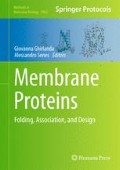Abstract
The development of methods for reversibly folding membrane proteins in a two-state manner remains a considerable challenge for studies of membrane protein stability. In recent years, a variety of techniques have been established and studies of membrane protein folding thermodynamics in the native bilayer environments have become feasible. Here we present the thiol-disulfide exchange method, a promising experimental approach for investigating the thermodynamics of transmembrane (TM) helix–helix association in membrane-mimicking environments. The method involves initiating disulfide cross-linking of a protein under reversible redox conditions in a thiol-disulfide buffer and quantitative assessment of the extent of cross-linking at equilibrium. This experimental method provides a broadly applicable tool for thermodynamic studies of folding, oligomerization, and helix–helix interactions of membrane proteins.
Access this chapter
Tax calculation will be finalised at checkout
Purchases are for personal use only
References
You M, Li E, Hristova K (2005) FRET in liposomes: measurements of TM helix dimerization in the native bilayer environment. Anal Biochem 340:154–164
Duong MT, Jaszewski TM, MacKenzie KR (2007) Changes in apparent free energy of helix-helix dimerization in a biological membrane due to point mutations. J Mol Biol 371:422–434
Cristian L, Lear JD, DeGrado WF (2003) Use of thiol-disulfide equilibria to measure the energetics of assembly of transmembrane helices in phospholipid bilayers. Proc Natl Acad Sci USA 100:14772–14777
Chen L, Novicky L, Hristova K (2010) Measuring the energetic of membrane protein dimerization in mammalian membranes. J Am Chem Soc 132:3628–3635
DeGrado WF, Gratkowski H, Lear JD (2003) How do helix-helix interactions help determine the folds of membrane proteins? Perspectives from the study of homo-oligomeric helical bundles. Protein Sci 12: 647–665
MacKenzie KR, Fleming KG (2008) Association energetics of membrane spanning α-helices. Curr Opin Struct Biol 18:412–419
Regan L, Rockwell A, Wasserman Z, DeGrado WF (1994) Disulfide crosslinks to probe the structure and flexibility of a designed four-helix bundle protein. Protein Sci 3: 2419–2427
Zhang Y, Kulp DW, Lear JD et al (2009) Experimental and computational evaluation of forces directing the association of transmembrane helices. J Am Chem Soc 131: 11341–11343
Cristian L, Lear JD, Degrado WF (2003) Determination of membrane protein stability via thermodynamic coupling of folding to thiol-disulfide interchange. Protein Sci 12: 1732–1740
Stouffer AL, Ma C, Cristian L et al (2008) The interplay of functional tuning, drug resistance, and thermodynamic stability in the evolution of the M2 proton channel from the influenza A virus. Structure 16:1067–1076
North B, Cristian L, Fu Stowell X et al (2006) Characterization of a membrane protein folding motif, the Ser zipper, using designed peptides. J Mol Biol 359:930–939
Choma C, Gratkowski H, Lear JD, DeGrado WF (2000) Asparagine-mediated self-association of a model transmembrane helix. Nat Struct Biol 7:161–166
Walshaw J, Woolfson DN (2001) Socket: a program for identifying and analysing coiled-coil motifs within protein structures. J Mol Biol 307:1427–1450
Mason JM, Arndt KM (2004) Coiled coil domains: stability, specificity, and biological implications. Chembiochem 5:170–176
Yu YB (2002) Coiled-coils: stability, specificity, and drug delivery potential. Adv Drug Deliv Rev 54:1113–1129
Acharya A, Rishi V, Vinson C (2006) Stability of 100 homo and heterotypic coiled-coil a-a′ pairs for ten amino acids (A, L, I, V, N, K, S, T, E, and R). Biochemistry 45:11324–11332
Wagschal K, Tripet B, Lavigne P, Mant C et al (1999) The role of position a in determining the stability and oligomerization state of alpha-helical coiled coils: 20 amino acid stability coefficients in the hydrophobic core of proteins. Protein Sci 8:2312–2329
Lamb RA, Zebedee SL, Richardson CD (1985) Influenza virus M2 protein is an integral membrane protein expressed on the infected-cell surface. Cell 40:627–633
Holsinger LJ, Lamb RA (1991) Influenza virus M2 integral membrane protein is a homotetramer stabilized by formation of disulfide bonds. Virology 183:32–43
Pinto LH, Holsinger LJ, Lamb RA (1992) Influenza virus M2 protein has ion channel activity. Cell 69:517–528
Wang C, Takeuchi K, Pinto LH, Lamb RA (1993) Ion channel activity of influenza A virus M2 protein: characterization of the amantadine block. J Virol 67:5585–5594
Ren J, Lew S, Wang J, London E (1999) Control of the transmembrane orientation and interhelical interactions within membranes by hydrophobic helix length. Biochemistry 38: 5905–5912
Killian JA (1998) Hydrophobic mismatch between proteins and lipids in membranes. Biochim Biophys Acta 1376:401–416
Adamian L, Liang J (2002) Interhelical hydrogen bonds and spatial motifs in membrane proteins: polar clamps and serine zippers. Proteins: Struct Funct Genet 47: 209–218
Yin H, Slusky JS, Berger BW et al (2007) Computational design of peptides that target transmembrane helices. Science 315: 1817–1822
Author information
Authors and Affiliations
Editor information
Editors and Affiliations
Rights and permissions
Copyright information
© 2013 Springer Science+Business Media, LLC
About this protocol
Cite this protocol
Cristian, L., Zhang, Y. (2013). Use of Thiol-Disulfide Exchange Method to Study Transmembrane Peptide Association in Membrane Environments. In: Ghirlanda, G., Senes, A. (eds) Membrane Proteins. Methods in Molecular Biology, vol 1063. Humana Press, Totowa, NJ. https://doi.org/10.1007/978-1-62703-583-5_1
Download citation
DOI: https://doi.org/10.1007/978-1-62703-583-5_1
Published:
Publisher Name: Humana Press, Totowa, NJ
Print ISBN: 978-1-62703-582-8
Online ISBN: 978-1-62703-583-5
eBook Packages: Springer Protocols

